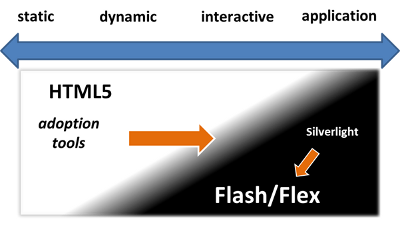Adobe has recently made a number of rather muddled announcements around Flash and Flex that have caused confusion and concern in the development community. In this post I hope to clarify what actually has been said and present my take on what it might actually mean for those of us on the receiving end.
Adobe has made it clear over the past while that, like the other big players, they see HTML5 as a major force for expressive and rich content on the web. Actions such as the acquisitions of PhoneGap and Typekit, the development of Edge and Wallaby and their contributions to WebKit, jQuery and the CSS3 specification have backed up their openness about where they see the future heading. Unfortunately, how they see Flash (and Flex) fitting into this vision has been a little unclear, and recent announcements have only confused matters further.

Image used under creative commons licence from Janielle Beh
Flash
The most misunderstood and misreported of the announcements is that Adobe is ceasing active development of the Flash Player plug-in for mobile browsers, i.e. there will be no new versions of the browser plug-in for your mobile phone or tablet (except for critical patches). Development of the desktop browser version of the plug-in is very much continuing, with various interesting new APIs and features already announced for Flash Player 12. Personally, I am not surprised by the announcement regarding the plug-in for mobile browsers.
As users on mobile devices we don't really use, expect or want overly rich content on the browser because it tends to be cumbersome due to high network latency and expensive (depending on your data tariff). Rather, we go to apps whenever we want anything more than fairly static content. Without an equivalent ubiquity to that on desktop browsers, Flash Player is never going to be in any kind of position to even attempt to change that behaviour, and attempting to achieve that penetration looks like a complete non-starter considering the platforms blocking it outright and the vast resources apparently required to support it for the others
In addition to these reasons, the ubiquity of modern, HTML5-supporting browsers on mobile devices undermines one of the other strong motivations for the use of Flash Player. Namely, that it is a solution to the issue of backwards-compatibility and feature support that plagues development for desktop browsers. Few would argue that HTML5 as it currently stands on mobile devices is unable to reliably provide the (limited) richness desired for web content.
Flex
The (rather tepid) announcement regarding Flex that Adobe has made is that after the release of Flex 4.6 in a few weeks, governance of the SDK development is going to change significantly. It is going to be handed over to an open source foundation consisting of members of the current development team, developers from the community, members of the Spoon Project and contributors from enterprise companies. In some respects Adobe has in the past hinted that something like this might happen. At AdobeMAX 2010, Deepa Subramaniam mentioned that they were considering allowing community developers to submit patches that would have to pass through Adobe's test suits before becoming candidates for inclusion, and this move seems like a logical extension of that train of thought. I feel the Flex SDK actually now requires the kind of TLC only a more open governance can provide because I think it could do with a focus on behind-the-scenes fixing and improving rather than glamorous, headline-grabbing new features.
Flex developers are understandably confused and frustrated by this announcement. As recently as AdobeMAX 2011, Adobe appeared to be giving a strong message about the future of Flex as its solution for enterprise-grade development, with a clear roadmap. The change of governance inevitably means a change of roadmap, regardless of how strong an influence Adobe might have over the new foundation. With hindsight, it is perhaps more obvious that Adobe's enterprise-related angle has actually related to the future of Flash Player rather than Flex. However, rather than being upset by the timidity with which Adobe has approached this change and seeing it as a negative move, I think the Flex community and business and enterprises with a stake in the technology should embrace this change and realise the opportunity it potentially provides. There is a lot of money and time committed to Flex other than Adobe's and Adobe is still fully committed to the technologies that underpin Flex, both Flash and AIR, so it is all but guaranteed for the foreseeable future at the very least.

Image used under creative commons licence from Janielle Beh
AIR
At the same time as all of this, Adobe has firmly re-stated its commitment to AIR. Most of the development of the desktop Flash Player plug-in carries over into AIR, and a whole number of new AIR features primarily targeting mobile devices have also been announced. With the recognition that users go to apps for rich content on mobile devices this makes absolute sense, given that, in my opinion, AIR is one of the best genuinely cross-platform development targets. Flex developers in particular should take heart from this, considering the close coupling between the Flex framework and the AIR API. Over time, we may start seeing the runtime shift more towards its JavaScript and HTML capabilities or, at least, applications taking more explicit advantage those capabilities, but at worst AIR would allow a smooth and transparent transition between the technologies.
Summary
Overall, my impression is that Adobe have a similar view on how HTML5 and Flash will play out in the short and long term to the one we laid out in our white paper. Namely, in the short term, the richer, more interactive and dynamic the content/application being developed requires, the clearer the choice for Flash/Flex over HTML5 is. However, over time, as tooling, developer skills and technology improve, and the spread of mobile devices continues at its current pace, HTML5 is likely to become the "better" choice rather than Flash/Flex.

The exciting prospect here is that, historically, what Adobe has excelled at is tooling rather than technology. Photoshop, Premiere, Illustrator, Flash Professional and others are unquestionably fantastic tools, and Edge has already hinted that Adobe could reach similar standards for HTML5 authoring. Adobe's experience in bona fide IDEs comes primarily from its Flash and Flex tools so it would be reasonable to expect that any new HTML5 tools will feel fairly natural to any developers used to their existing IDEs. Again, Edge supports this view, since it is remarkably similar to the older Flash authoring tools.
It is interesting to contrast Adobe's apparent approach to the future with HTML5 against that of Google and Microsoft. Where as Adobe appears to content to position itself strongly somewhat on the sidelines from where it might have a better vantage point to allow it to dive in when appropriate, Google and Microsoft seem, to some degree, more intent on outright dictation of the direction we're all heading in. Regardless of how things pan out, it's going to continue to make for a fascinating spectacle.
UPDATE: Head here for my colleague Colin's more general thoughts relating to these announcements, they are well worth a read
UPDATE: The Flex team have added further information to their announcement that further justify my call for optimism.
